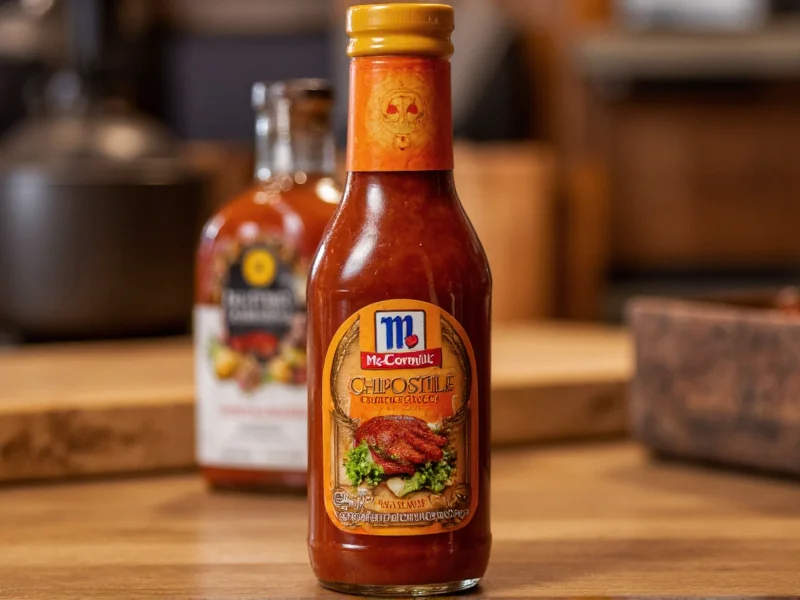Understanding how to effectively incorporate McCormick Chipotle Sauce into your cooking can transform ordinary meals into restaurant-quality dishes with minimal effort. This comprehensive guide explores the culinary applications, flavor profile, and practical usage tips for this versatile pantry staple.
Understanding McCormick Chipotle Sauce Composition
McCormick Chipotle Sauce delivers consistent flavor through its carefully balanced formulation. Unlike homemade versions that require roasting peppers and blending multiple ingredients, this commercial product provides reliable smokiness without the preparation time. The sauce maintains a medium heat level (approximately 2,500-8,000 Scoville units) that enhances dishes without overwhelming other flavors.
When examining the McCormick Chipotle Sauce ingredients list, you'll find water, tomato paste, vinegar, less than 2% of chipotle peppers, salt, spices, garlic powder, and natural smoke flavor. This formulation creates a smooth texture ideal for marinades, dressings, and sauces. The absence of artificial preservatives makes it suitable for clean-eating approaches while maintaining shelf stability.
Culinary Applications and Pairing Guide
Chefs and home cooks alike appreciate how to use McCormick Chipotle Sauce in recipes across various cuisines. Its versatility shines in multiple cooking applications:
| Dish Category | Recommended Usage | Flavor Enhancement |
|---|---|---|
| Proteins | 2-3 tbsp per pound as marinade | Adds smoky depth to grilled meats |
| Vegetables | 1-2 tsp roasted vegetable toss | Complements sweet potatoes and corn |
| Soups & Stews | 1-2 tbsp per serving | Boosts complexity in bean dishes |
| Dips & Spreads | 1-3 tbsp per cup base | Creates restaurant-style dips |
Practical Usage Tips for Home Cooks
Mastering McCormick Chipotle Sauce recipe ideas requires understanding proper incorporation techniques. Add the sauce during the final 10-15 minutes of cooking to preserve its delicate smoke flavor, which can dissipate with prolonged heat exposure. For salad dressings, emulsify with olive oil at a 1:3 ratio to prevent overpowering bitterness.
When exploring McCormick Chipotle Sauce substitution options, consider that one tablespoon equals approximately two minced chipotle peppers in adobo. This conversion helps when adapting recipes designed for homemade versions. The sauce works particularly well as a base for quick barbecue sauces when combined with ketchup and brown sugar.
Storage Guidelines and Shelf Life
Proper storage ensures optimal flavor retention for McCormick Chipotle Sauce shelf life considerations. Unopened bottles maintain quality for 18-24 months in a cool, dark pantry. After opening, refrigerate and use within 4-6 weeks for best results. The sauce may separate naturally over time—simply shake well before use to restore consistency.
For meal preppers, consider freezing portions in ice cube trays then transferring to freezer bags. This method provides convenient single-serving portions for how to use McCormick Chipotle Sauce in meal prep applications without waste.
Comparing Commercial and Homemade Options
Understanding McCormick Chipotle Sauce vs homemade preparations helps determine when convenience outweighs customization. Commercial sauce offers consistent flavor and texture with minimal preparation time, while homemade versions allow heat level adjustments and ingredient customization.
Nutritionally, McCormick Chipotle Sauce nutritional information shows approximately 5 calories per tablespoon with 110mg sodium. Homemade versions typically contain similar calories but may have higher sodium depending on added ingredients. The commercial product's advantage lies in its balanced flavor profile achieved through professional formulation.
Creative Recipe Applications
Expand your culinary repertoire with these best dishes for McCormick Chipotle Sauce applications:
- Breakfast boost: Swirl into scrambled eggs or mix with mayo for breakfast sandwiches
- Marinade magic: Combine with olive oil and lime juice for chicken or shrimp
- Dip transformation: Blend with sour cream for instant restaurant-style dipping sauce
- Soup enhancer: Stir into black bean soup for authentic Southwestern flavor
- Grain bowl accent: Drizzle over quinoa or rice bowls for smoky complexity
Professional chefs often use this sauce as a flavor foundation rather than a finishing condiment. Its balanced profile works particularly well in dishes requiring subtle heat without vinegar dominance common in many hot sauces.
Frequently Asked Questions
What's the difference between McCormick Chipotle Sauce and adobo sauce?
McCormick Chipotle Sauce contains chipotle peppers (smoked jalapeños) already blended with adobo sauce, creating a ready-to-use product. Traditional adobo sauce refers specifically to the tomato-based seasoning liquid that chipotle peppers are packed in. The McCormick product offers a smoother, more consistent texture designed for direct culinary application without additional preparation.
Can I use McCormick Chipotle Sauce as a hot sauce substitute?
Yes, but with flavor adjustments. While McCormick Chipotle Sauce provides heat, it has a thicker consistency and more complex smoky-sweet profile than traditional hot sauces. For direct substitution, thin with vinegar or citrus juice and adjust sweetness to match your preferred hot sauce characteristics. It works particularly well as a substitute in recipes requiring smoky heat rather than pure vinegar-based heat.
How can I reduce the heat level of McCormick Chipotle Sauce?
To mellow the heat, blend the sauce with equal parts Greek yogurt, sour cream, or mayonnaise. For cooking applications, incorporate it gradually while tasting, and balance with acidic components like lime juice or sweet elements like honey. The heat level can also be reduced by simmering the sauce gently for 5-7 minutes, which helps mellow the capsaicin compounds while preserving smoky flavor.
Is McCormick Chipotle Sauce gluten-free?
Yes, McCormick Chipotle Sauce is certified gluten-free. The product contains no wheat, barley, rye, or related grains in its formulation. However, always check the current label as formulations can change, and verify with the manufacturer if you have severe gluten sensitivity. The manufacturing facility follows strict protocols to prevent cross-contamination with gluten-containing products.
What are the best store-bought alternatives to McCormick Chipotle Sauce?
When McCormick Chipotle Sauce is unavailable, consider Trader Joe's Chipotle Hot Sauce or Texas Pete Chipotle Sauce as closest alternatives. For similar flavor profiles, blend regular hot sauce with smoked paprika (1/4 tsp per tablespoon) or use pureed chipotle peppers in adobo with tomato paste. Note that homemade versions require additional preparation but offer greater customization of heat level and flavor balance.











 浙公网安备
33010002000092号
浙公网安备
33010002000092号 浙B2-20120091-4
浙B2-20120091-4